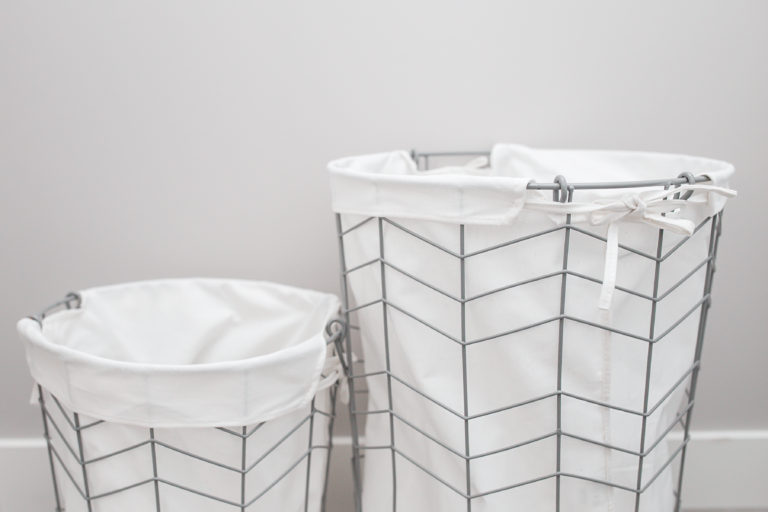How to Make & Maintain a Master List of Tasks
I always thought it would be cool to be a grown-up. I could decorate my own house and eat whatever I wanted. Ha! That’s cute. Turns out I can eat ice cream for dinner, but adulting is also full of little to-dos that have to get done. How do you keep track of all of them?
I find that without a schedule or a plan, things just….don’t happen. My four year old actually took the initiative to clean out our refrigerator the other day. If that doesn’t tell you how long it had been since it had last been cleaned, I don’t know what does!
The point is – if there’s no specific time to do something, odds are it won’t get done. That’s why you need a system!
This process will help you make a master list of tasks!

1. Make a Master List of Tasks
Sit down and make a list of everything that has to get done. The way I think of it is that the list should include things that don’t have some sort of obvious trigger. For example, when my nails annoy me, I trim them. Doesn’t need to go on the list. When my prescriptions are out, I refill them. Doesn’t go on the list.
On the other hand, there’s no obviously trigger point for when my air filters need to be replaced or I need to get a haircut. You don’t get an indication it needs to happen until it’s well overdue. That’s my cutoff for the list. You may have your own of course!
Now then, there are a couple of ways to slice and dice your list. I’m going to give you a couple of different methods to get started. I’ve also put together a super exhaustive list of 80+ tasks – sliced two ways – that you can download to help you get going on your own list.
2. How do I organize my tasks?
Once you make a list, you need to organize it somehow. Otherwise, you’ll have trouble keeping track of when you need to do everything. To organize your tasks, there are two different options.
Option 1: Time-Based List
My sister keeps lists of items to be done yearly, twice a year, monthly and daily. You could also add other time intervals if you need to (weekly, etc.). This is all about your style! Here’s an example of what this might look like. (Don’t forget to download the cheat sheet for much more.)
Yearly
Yearly tasks are the items that happen infrequently. These are the most important to list because they don’t happen often. It’s much easier to forget something when it only needs to be done once a year. Examples of yearly tasks might be:
- Pay property taxes
- Pay Homeowner’s Association Dues
- Kids annual well-child visits
- OB/GYN visits
- Vehicle Inspections & Registration Renewals
Some of these should occur at specific times (like paying your property taxes). Others might not need to happen at specific times (like your OB/GYN visit). We’ll tackle how to organize all of these tasks later on. For now, it’s important to just get them all down somewhere.
Two to Four Times a Year
Some items happen two to four times a year. These are also infrequent enough that you really need to track them. Otherwise, it would be very easy to forget. Some things that might happen a few times a year are:
- Car insurance renewal
- Dentist
- Haircuts
- Oil Changes
- Cleaning out the refrigerator
- Cleaning out the pantry
- Donating old/outgrown clothes
- Updating kids’ clothes for next sizes
- Clean out old makeup, toiletries and cleaning supplies
The tasks that happen multiple times a year again may or may not have to happen at a specific time. Your car insurance renews on specific dates based on your plan. Cleaning out the refrigerator and pantry, on the other hand, are notoriously hard to pin down. When, exactly, is it the right time to do that? If you’re like me, it’s never the right time! That’s why it’s so important to have a system.
Monthly
There are tons of tasks that need to be done monthly. Although these happen more frequently than yearly or quarterly items, they’re still not common enough to be easily habit-forming. That’s why they’re so important to track. Monthly tasks might include:
- Changing air filters
- Changing contact lenses
- Dog heartworm medication
- Washing bath mats
Weekly
Once you get down to weekly tasks, you might have enough of a routine around them that you don’t have to add them to the list. If you’re busy or disorganized like I am, though, you might benefit from keeping track of weekly tasks. Your list might look something like this:
- Wash and change bed sheets
- Take clothes to be dry-cleaned
- Buy groceries
- Meal plan
- Exercise (3 times/week)
- Wash hair (twice a week)
- Shave legs (twice a week)
I find that, even with weekly tasks, it really helps me to have a designated day to do each task. For example, I always wash the sheets on Tuesday (after the cleaners come) and I always order groceries on Monday. That way I don’t have to think about it! The key is: eliminate decisions whenever possible.
Daily
Having a daily list can be really handy to help you keep up with household tasks. I know that I frequently fall behind if I let the daily tasks slide. Here are some things that might go on the daily list:
- Do a load of laundry
- Fold and put away a load of laundry
- Load and empty the dishwasher
- Spend 10 minutes picking up toys and clutter
- Sort mail
- Clean out kids’ lunchboxes and backpacks
Option 2: Category-Based List
Another approach is to divide your list into categories. The full list would contain the same items as the time-based list, but you’ll organize them in a different way. Some examples of categories might be home, self-care, health, kids, vehicles, finances and travel.
This approach will help you really think through the things you need to do in each area of life! Make sure to note the frequency and due dates of each task, even though you’re organizing the list by category. I’ll give you some examples of how these lists might look, but check out the download for a more complete list!
Household
It’s truly amazing how many chores there are around the house. So many of them don’t have to be done at any specific time, so it’s easy to let them go. But when you don’t take care of your space, you’ll end up feeling grumpy and spending more money to deal with issues later. That’s why it’s important to stay on top of home maintenance and household tasks. Here’s what a household list might look like:
- Clean out gutters (annually)
- Power Wash exterior (annually)
- Clean out pantry (quarterly)
- Empty and wipe down fridge (quarterly)
- Change air filters (monthly)
- Wash bed sheets (weekly)
Self-Care
Even low-maintenance ladies like myself seem to amass some self-care and beauty-related tasks. These are really things that don’t have to happen at a particular time, yet I find that they make a huge difference in how I feel about myself! My list includes:
- Haircut (quarterly)
- Keratin treatment (annually)
- Eyebrow Waxing (every other month)
- Bikini Waxing (every other month)
- Pedicure (twice a year)
- Massage (once a month)
Health
There are plenty of health-related appointments to keep track of. Since doctors’ schedules can fill up fast, it’s really important to stay on top of medical tasks. These tasks can also have implications for your children.
For example, to start Kindergarten, most students need to have a physical examination and the required immunizations. Don’t delay this or you may have a problem enrolling your child in school! Here’s a list of some health-related tasks that might go on your list:
- Dentist for all family members (twice a year)
- OB/GYN (annually)
- Adult physicals (annually)
- Well child visits (annually)
- Eye doctor (annually)
- Mammogram (annually after 40)
Pets
We just got a dog, and let me tell you – it’s just another set of lists! My dog needs almost as much maintenance as my kids…maybe more! Here’s my current pet list, and I’m sure I’ll add to it over time:
- Heartworm medication (monthly)
- Flea/tick medication (monthly)
- Immunizations (twice a year)
- Tri-wormer required by doggie daycare (annually)
- Grooming (once a month)
- Nail trimming (quarterly)
Finances
It’s important to keep up with your financial to-dos. These can have real implications on your future quality of life, so it’s extra important to take care of these items on time. Here’s what a financial list could look like:
- Pay property taxes (annually)
- Submit income taxes (annually)
- Review investment portfolio (quarterly)
- Save money for kids college fund (monthly)
- Review expenses and update budget (monthly)
- Balance checkbook (monthly)
- Review credit card activity for fraud (weekly)
- Check credit report for issues (monthly)
Recap of Steps 1 & 2: Make & Organize Your List
Here are the key points to remember when making a list:
- Contains items that don’t have a natural trigger (e.g refilling a prescription doesn’t need to be on the list)
- Doesn’t contain items that are already part of your habits (e.g. brushing your teeth doesn’t need to be on the list)
- The list can be organized by frequency, category or both!
- Remember to download the printable list to help you get started on your own.
3. How do I track lists effectively?
After you’ve made your awesome (and potentially daunting) list, you have to find a way to remember to do everything! There are two options for doing this. You can take a calendar-based approach and schedule everything. Or you can keep your list in a bullet journal and mark tasks as they happen. Learn a bit more about each option and then decide which will work better for
Option 1: Use a Calendar-Based Approach
One way to remember to do the items on your list is to use a calendar-based approach. This works really well for me because it matches how I think about my days. I look at my calendar frequently and my calendar really governs what’s happening on any given day. As I’ve said before, if it’s not on the calendar, it’s not happening!
To implement this approach, I recommend three steps to put everything on your to-do list onto your calendar.
Group 1: Time-Sensitive Items
After you have a list of all of your to-dos, you need to handle them bit by bit. It will be too overwhelming to try to cope with the entire list at once, which is why I want you to break it down into a couple of manageable chunks.
The first type of tasks we’ll tackle is items that have to occur by a particular date. These are pretty easy to handle because you can simply put them into your calendar. I suggest putting a reminder on your calendar slightly before the event occurs so you can make sure to have it done on time. For annual and quarterly tasks, a 1-2 week buffer is appropriate. For monthly tasks, a buffer of a couple of days is fine.
Some examples of events that are great for your calendar are:
- Pay property taxes
- Pay Homeowner’s Association Dues
- Submit income tax return
- Pay auto insurance renewals
- Inspect vehicles
- Renew vehicle registration
- Scheduling birthday parties
Some of these items have a fixed due date for everyone, like paying your property taxes. Others have a date that is specific to you, but still clear, like scheduling birthday parties and renewing your vehicle registration. These dates aren’t changing, so putting them in the calendar is perfect.
For calendar management, I highly recommend a Google Calendar. You can and should send calendar invitations to your significant other. This is how to stay in sync on calendar-based tasks.
Group 2: Items you can schedule after completing the current iteration
The next category of items are those that you can schedule after you complete the current visit. Many doctor and self-care appointments fall into this category. When you’re leaving your waxing appointment, schedule the next one. Same for doctors, if possible.
When your doctor appointment is annual, the doctors’ office may not be scheduling that far out yet. If this is the case, put a reminder in your calendar for about 4 months out to schedule the appointment. If you put the reminder into your calendar (for the next year) on the day of your appointment (in the current year), you’ll be sure not to forget.
This method works so well because you have to overcome intertia to cancel rather than to keep the appointment. I’ve found that’s it’s much better to have something on the calendar already, because even an appointment I can’t make is a trigger to remind me to reschedule it. If I haven’t made that next appointment, on the other hand, who knows whether I’ll remember to follow up or not.
Group 3: Choose an Anchor Date
For everything that doesn’t fall into one of the above categories, you have to come up with some sort of system to decide when to do things. The items that fall into this category don’t have to happen by a specific date and don’t need to be scheduled ahead of time. This is the list of things like: change the air filters, power wash the exterior of the house, buy the kids new clothes.
For this sort of thing, I suggest choosing dates for each item. To give you an example of how this might work, you might decide that all self-care, health, kid and pet monthly tasks will happen on the first of the month. All household, financial and vehicle monthly tasks will occur on the 15th of the month.
For weekly tasks, I highly suggest a weekly schedule. For example, you might wash the towels every Sunday and drop off the dry-cleaning every Monday. The point here is to think about these tasks as little possible.
If you need a big paper calendar, do it! The easier this is to see, the less you’ll have to think. And that’s the whole point!
Option 2: Use a Bullet Journal Approach
The bullet journal approach works really well for my sister. It’s very concise and lists everything in one place, which can be helpful if you need to see your tasks at a glance. My sister breaks it down by task frequency.
Step 1: Set up your Bullet Journal pages
In my sister’s journal, she has the following pages:
- Annual
- Twice a year
- Monthly
- Weekly
On each page, there is a space to mark the task done. She can also note when the task has to occur when the items does have a specific due date.
Step 2: Set aside time to review
I think the key to succeeding with the bullet journal approach is to be disciplined about reviewing your list. Set aside a time at least once a week to review the list and handle any upcoming tasks. Decide when it makes sense to do tasks that aren’t time-based. For example, you might want to resolve to take care of monthly tasks as early as possible, just to prevent yourself from procrastinating.
Keeping up with Your “I’m a Grown-Up” Master Household List
Don’t live in fear of forgetting to pay your property taxes – or of the scary stuff growing in your fridge! Make a list of everything you have going, organizing the tasks either by frequency or category. Then make a plan to tackle the lists, using either your calendar or a bullet journal approach.
When you find a time to do all of the stuff that needs doing, you’ll be able to stay on top of life. Just remember to have some ice cream for dinner every once in awhile. You know, to remind yourself of the good stuff that comes with being a grown up.







Omg I love this! I will share it with my readers tomorrow!
Thank you!! Have to give credit to my sisters who started this discussion and made me realize how badly I needed a List of Everything! 🙂
I loved this post, Beth.
I realised that I’m very loose about these things 🙂
The weekly things happen beautifully (and I do an organising/ house cleaning thing every weekend – this afternoon I cleared out receipts Jan – March), I have a system for some monthly things like photos, budgeting, scheduling friend dates and so on.
But those infrequent 2 – 4 times a year tasks? I do those when they annoy me. My hair desperately needs both a colour and a Keratin treatment – I’m supposed to go once every 3 months for the KT but I push it out because it’s so expensive and when it bugs the daylights out of me, then I’ll go. I last went on 9 December…
Medical stuff I put on my 19in2019 list and I make myself go 🙂
The infrequent tasks are so hard! I usually do my Keratin just once a year so I take a half day off of work and do it around my birthday. That’s my cue! Otherwise I would never do go.